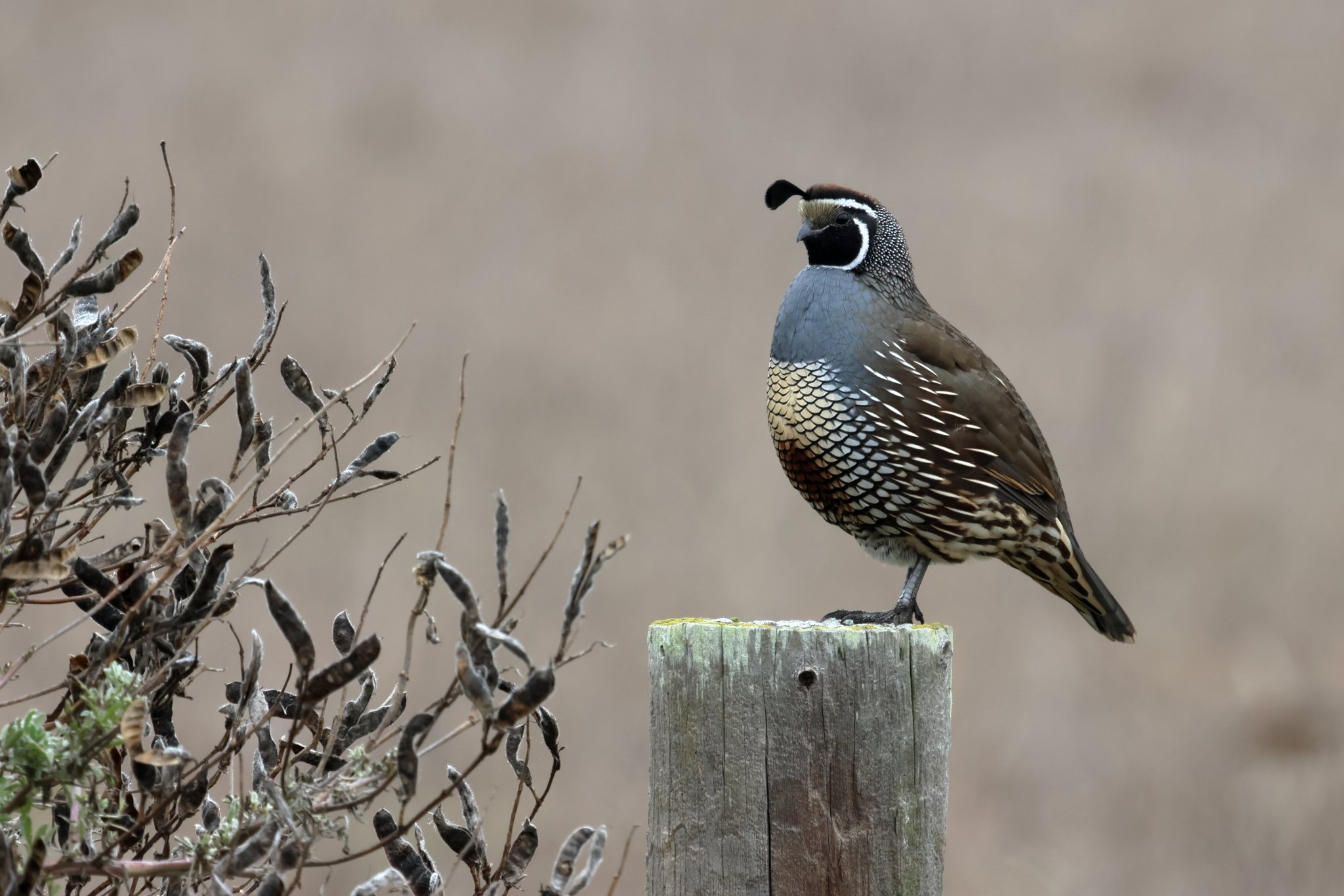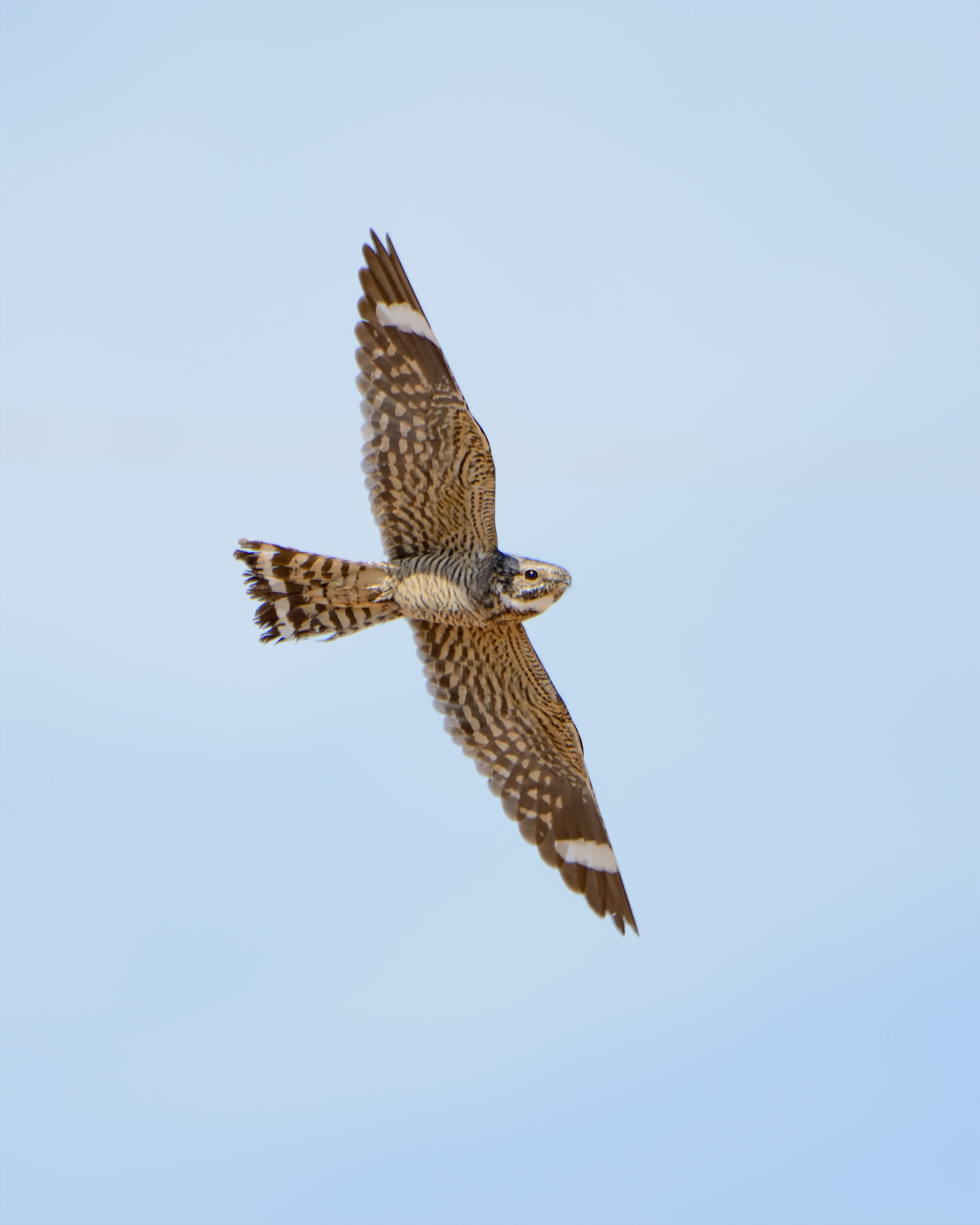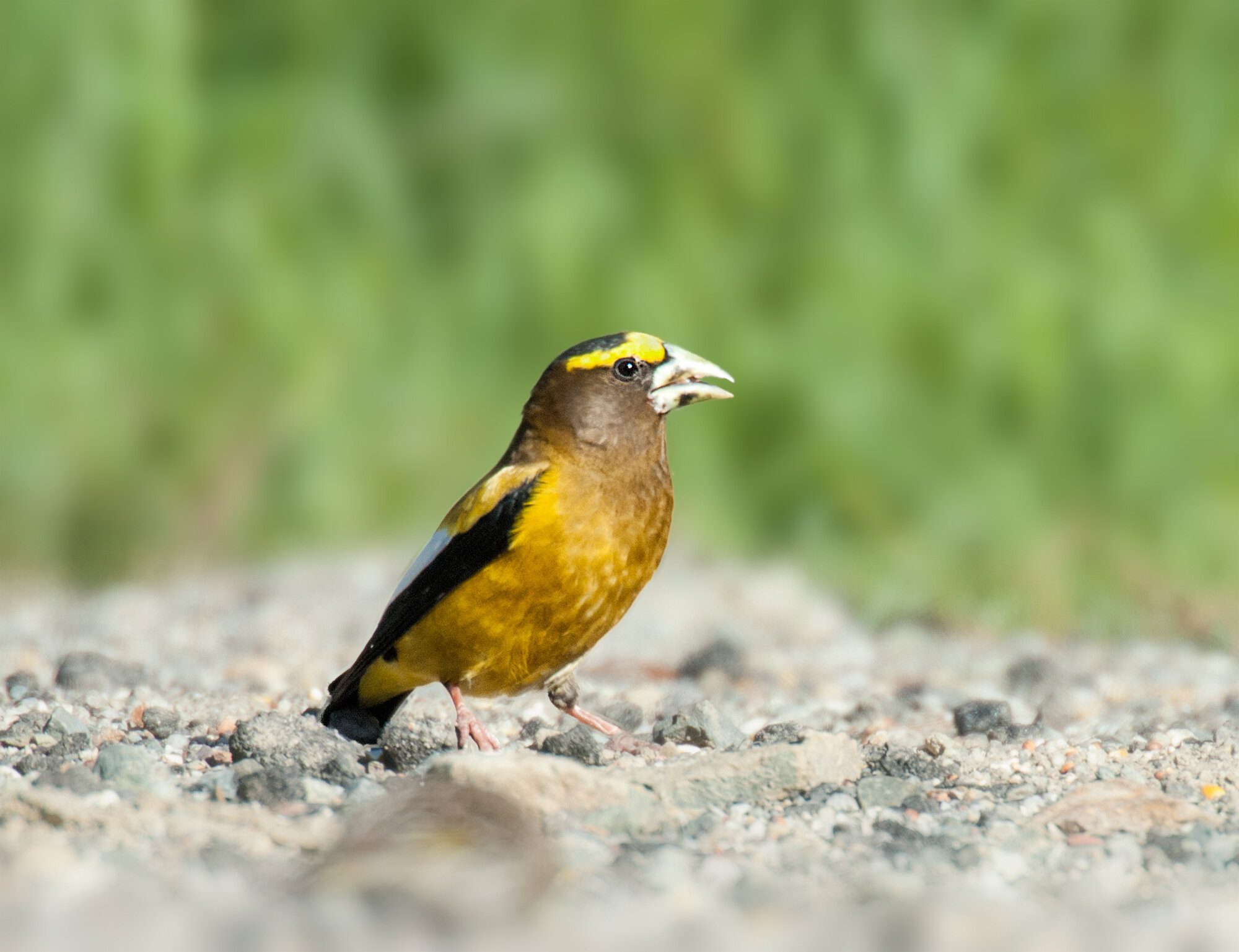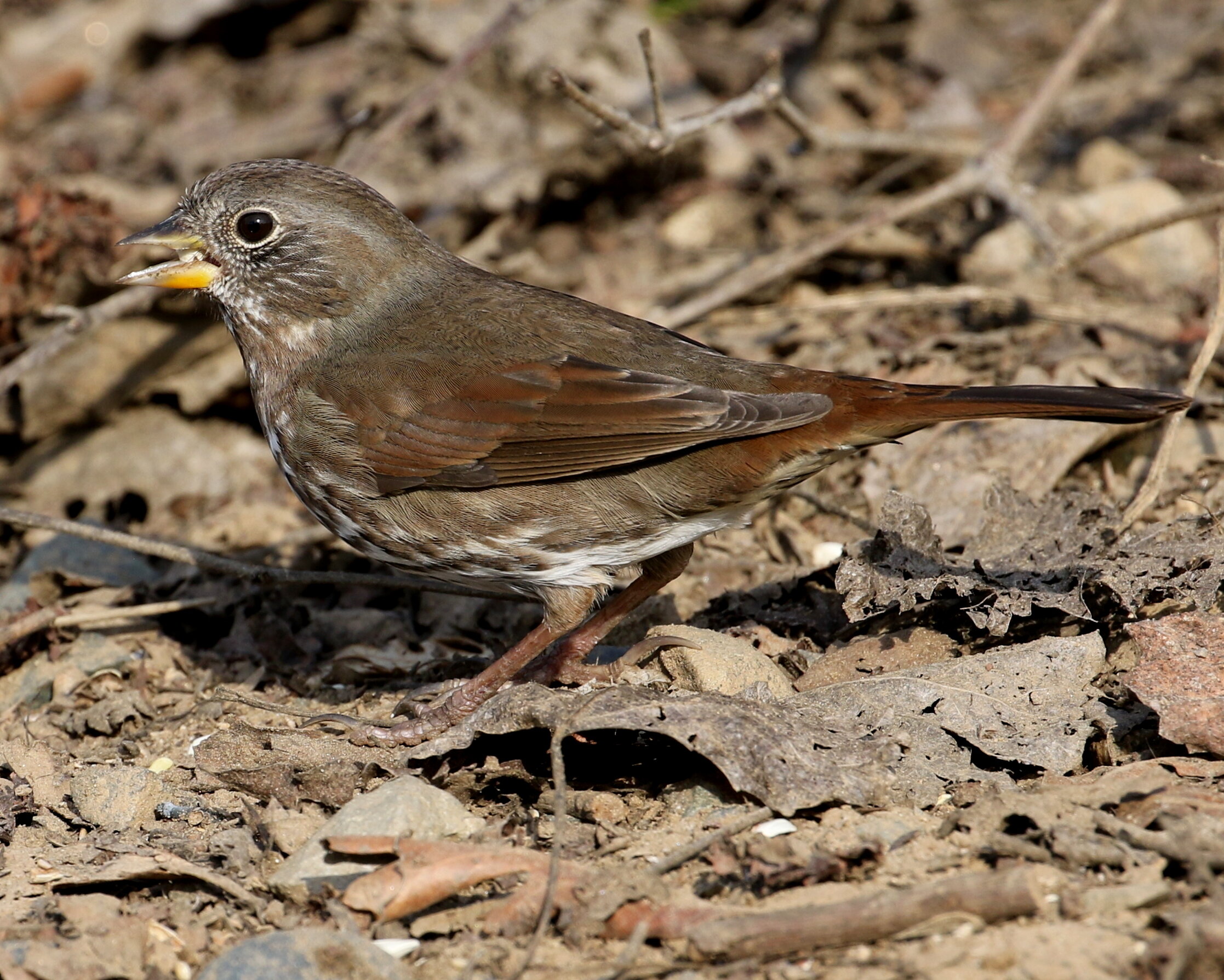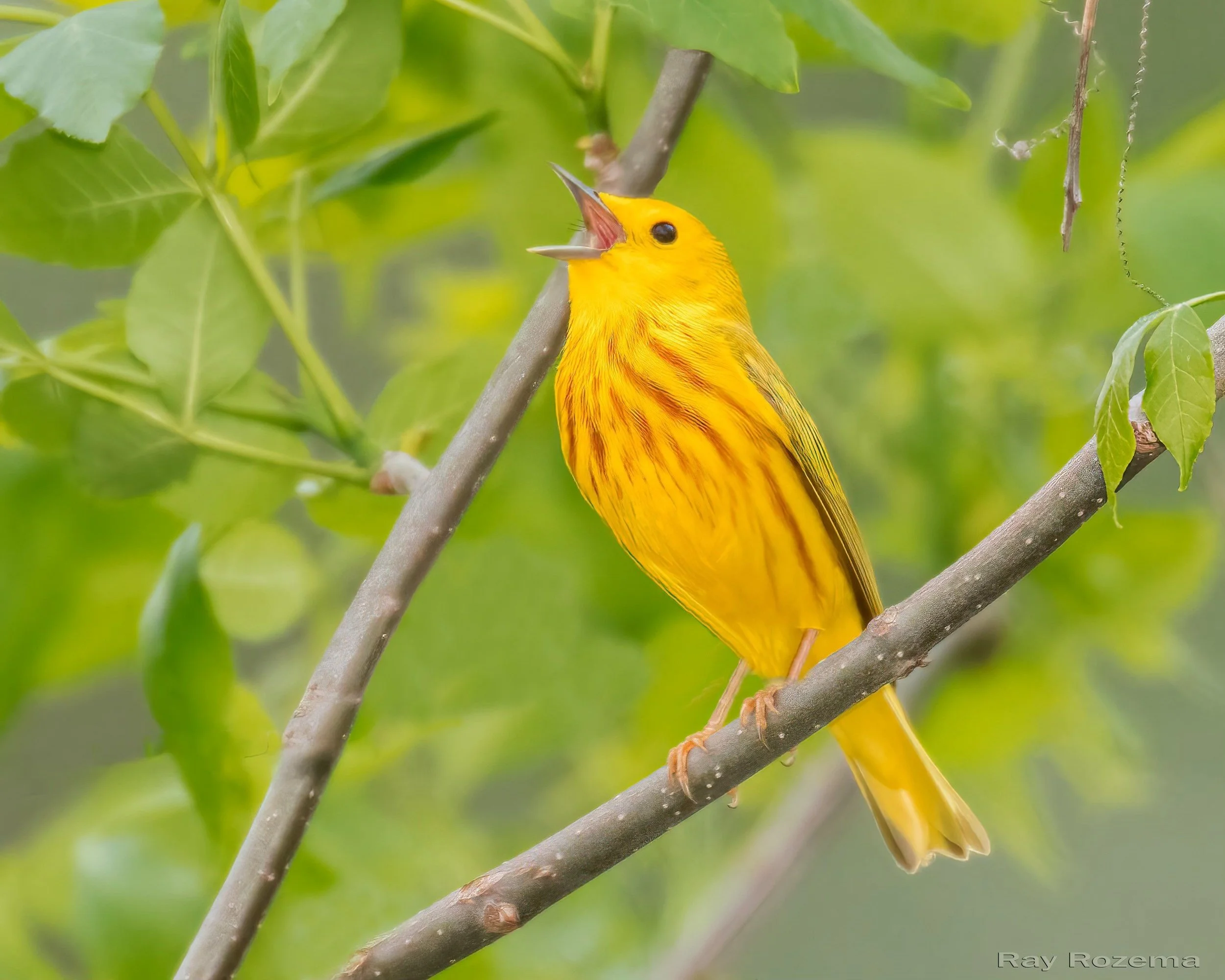SAS Field Trip: Sailor Bar, 06/14/2025
Black-chinned Hummingbird, Image by Mary Forrestal
Leaders Mary Forrestal and Jane Van Kessel reported: What a beautiful morning for a walk. Thirteen of us enjoyed the cooler temperatures and Sailor Bar proved once again that birding in the summer is worth the effort. The regulars dominated the morning with Oak Titmice, Bushtits, Bewick’s Wrens, and Spotted Towhees singing us along. The group enjoyed discussing the different ways to distinguish between swallows and swifts, the different types or swallows (Cliff, Tree, and Northern Rough-winged were all seen), and Black-chinned vs. Anna’s Hummingbirds. It was a great morning for raptors. Swainson’s Hawk, Red-shouldered Hawk, Red-tailed Hawk, Turkey Vulture, White-tailed Kite, and Bald Eagle were all seen. The Bald Eagle even put in a second appearance, seen at both the beginning and towards the end of the trip. There was only one Great Blue Heron juvenile still in the rookery but plenty of others were flying about, along with Green Herons and Great Egrets. If you’d like to see the complete list of birds recorded on the walk, it is here: https://ebird.org/checklist/S250280565.
SAS Field Trip: June Singers at the Bufferlands, 06/15/2025
It took awhile to find a singing Blue Grosbeak, Image by Daniel Lee Brown
Leader Chris Conard reported: Seventeen of us enjoyed a cool morning that warmed up as the day progressed. Almost immediately, we heard a Blue Grosbeak singing, but it took a little while to zero in on the bird. We saw at least three of them, plus abundant Song Sparrows, and Common Yellowthroats. Other highlights included flocks of American White Pelicans, Double-crested Cormorant nests with young, Cooper's, Swainson's and Red-tailed Hawks, a Pied-billed Grebe with two young, good numbers of herons and egrets, a fairly cooperative Belted Kingfisher, Ash-throated Flycatchers, and singing Black-headed Grosbeaks. View the checklist at https://ebird.org/checklist/S250748173
SAS Field Trip: William Pond Park, 06/21/2025
California Quail showing sentinel behavior, Image by Timothy Jackson
Leader Rachael Cowan reported: I gathered with 8 birders at William B. Pond on an early mid-June morning and we all shared gratitude for a beautiful day that could have been significantly warmer. Our group was a mix of familiar and new faces, including three younger women who shared it was their first time out birding “officially.” The group welcomed their excitement in shifting from backyard birds to something new. A male California Quail kindly posed atop a brush pile on the other side of the bike trail, offering a perfect subject for binocular focus tips for our new birders. We discussed the sentineling behavior and how it is a crucial survival tactic for quail, helping them to avoid predation. As we passed through the blackberries lining the path we paused to take in the morning chorus and observations of Spotted and California Towhees, as well as some Bushtits working the leaves deep within a dense live oak. Lesser Goldfinches were checking the fennel for seeds and as a House Finch was singing at the top of a nearby tree. Mourning Doves were switching from ground to trees, and we wondered if there were some recently fledged doves waiting for food deliveries on the ground. We were trying to make out a couple of sparrow-sized birds that switched from a treetop to the power lines and realized they were juvenile Brown-headed Cowbirds when we saw and heard them vocalize. I wondered if we were watching juveniles who recently found their true flock by responding to the adult’s chatter. We began to lament at the frequent observance of the cowbirds while remarking on the extraordinary conservation practices by the species.
White-tailed Kite, Image by Daniel Lee Brown
I thought I heard a flicker in the distance, but then we set our sights on a Northern Mockingbird pair, and I doubted my ear on the flicker. Just then we turned to face the sound of a Common Raven and saw five fly over in a group. The population has been growing on the Lower American River, and I wondered if this is a family of the season. We headed down toward the river and stopped to take in a call. It was a Common Yellowthroat! We never set eyes on the bird, but we all clearly heard the repeating whitchity-whitchity-witch. At the beach, we observed a wonderful assortment of species working their usual areas. A group of older Mallard ducklings greeted us at the edge of the water with their mother and a male further out. A Great Egret was hunting in the water near an island of nesting Canada Geese, and it startled a Spotted Sandpiper who flew away to another shore spot with a Green Heron and a Killdeer, and a Black Phoebe was fly-catching from a perch in the irises. A Double-crested Cormorant landed on a log, and I encouraged the new birders to look at their eyes through the spotting scope. And then one of the young women pointed out a white bird and we all were delighted to tell her she found a White-tailed Kite, and I once again encouraged her to look at the eyes. We observed Tree Swallows, Cliff Swallows, and a White-throated Swift move through the scenery. We spotted both Downy and Nuttall’s Woodpeckers as we headed to check on the rookery, which still had Great Blue Heron nestlings. It was a really fulfilling visit at the river! On our way back, we heard that flicker sound again and one of the birders saw a pair of Northern Flickers in a distant treetop. It was a great way to wrap up the trip. We had a total of 43 species on our checklist.
SAS Field Trip: Loney Meadow, 06/22/2025
At least 6 MacGillivray’s Warblers were seen foraging, Image by Ray Rozema
Leader Sonja Sorbo reported: A beautiful summer day provided a lovely backdrop for our group of four birders. We made a brief stop at the Discovery Trail off Bowman Lake Road and were lucky enough to spot a MacGillivray’s Warbler and a Lazuli Bunting —the latter was singing in full sunlight at the top of a nearby pine tree. A couple of miles farther down the road, we stopped the vehicle to watch a pair of Townsend’s Solitaire chase each other; they landed on a log just across the road. After arriving at the Loney Meadow trailhead parking lot, we stood near the vehicles and sighted and heard over half a dozen bird species within just a few minutes. Red-breasted Nuthatch, Mountain Chickadee, Western Tanager, Yellow-rumped Warbler, Steller’s Jay, Cassin’s Finch, Warbling Vireo, and American Robin all welcomed the morning with song. The theme of the day seemed to be “warblers and woodpeckers” — we had nice views of Red-breasted Sapsucker, Hairy and White-headed Woodpecker, and Northern Flicker while ambling down the trail through conifers. Once we reached a creek area with alders, we spotted Nashville, Wilson’s, Orange-crowned and Yellow Warblers. However, the command performance was given by a group of at least six MacGillivray’s Warblers who were bouncing around in a large swath of mountain whitethorn. We all had never seen so many of this species in such close proximity, so it was a memorable experience.
Olive-sided Flycatcher singing cemented its ID, Image by Daniel Lee Brown
As we passed by the meadow area, we noted Red-winged and Brewer’s Blackbirds and heard a Song Sparrow. The real treat here was a Wilson’s Snipe who flew right at us before diverting at the last second, circling back to the meadow. On a slope on the other side of the trail, numerous Dark-eyed Junco hopped about, ignoring the Green-tailed Towhee that passed next to them. High in the conifers, a Western Wood-Pewee called while his cousin, the Olive-sided Flycatcher, asked for “quick three beers” leaving no doubt as to its identity! At our lunch stop we were entertained by several Fox Sparrow (including a Thick-billed) and a Black-headed Grosbeak, bringing our bird tally for the day to 30 species.
Young Birders Club Field Trip: Capay Open Space, 06/28/2025
Lark Sparrow, Image by Chris Conard
Leader Mackenzie Hollender reported: Four other young birders and three parents met my father and I on this very hot afternoon at the Capay Open Space Park. Later in the evening, another young birder and another parent joined us. We noted the Tree Swallows flitting overhead, and a fly-by Swainson's Hawk while standing in the parking lot. As we headed down to the riverbed, we noticed many fly-by Mourning Doves, a calling Killdeer, and silhouetted hummingbirds zipping around the cottonwoods. We traveled along the riverbed until we were facing a small cliff wall with many holes near the top—a Bank Swallow colony. We spent a good amount of time watching these uncommon birds hunt high above the water and occasionally fly into burrows. We noted the bird's brown band across the chest and white face, differentiating it from the similar Northern Rough-winged Swallows that were also in the area. Also, at the site of the colony, multiple American Kestrels provided great looks as they perched in the bare trees above the cliff. From there we headed back along the riverbed and birded the perimeter of the entrance of the park. We got great looks at a California Towhee calling from some scrub. Nuttall's Woodpeckers trilled in the distance, and California Scrub Jays perched while holding their bills open to provide themselves with relief against the heat. Lark Sparrows landed at the top of a bare tree, a few California Quail scurried into cover, and a Western Kingbird foraged in an elderberry bush in the back of the parking lot.
Lesser Nighthawk was the focus of our evening outing, Image by Daniel Lee Brown
At 7:25 we headed towards the far end of the park to look out along the riverbed to see nighthawks, along the way spotting a family of four Ash-throated Flycatchers in a pine. At 7:32 pm our first Lesser Nighthawk flitted on bouncy, butterfly-like wingbeats above the riverbed. A few more solo nighthawks rose from the riverbed and traveled along it throughout the 7 pm hour. Once we arrived at the barbed-wire fence, we saw a head peeking out of a hole in a large square nest box, the unmistakable face of an American Barn Owl. We admired the bird from a respectable distance. From there, we walked to a nice spot that overlooked the riverbed and waited for more nighthawk activity to begin. Around 8:15, a group of three nighthawks began flying low over the open ground, back and forth. We watched one of the birds pursue close behind a second bird with its white throat puffed out. Further into the evening, two more nighthawks flapped higher in the sky and traveled in very close proximity to our spot, providing stellar looks at the glowing white wing bars and intricate patterns of dusty brown, buffy, and darker brown. We were also able to admire a perched nighthawk on a piece of dead wood, and could hear its faint, eerie toad-like trill. While we were nighthawk watching, a Northern Mockingbird with a spot-on Western Kingbird impression melodied us. More and more nighthawks came into view from all directions as the evening advanced until our count stood at about 20. Overall, it was an incredible experience to get to know these unique birds in one of their northernmost breeding areas.
SAS Field Trip: Yuba Pass and Sierra Valley, 06/28/2025
Evening Grosbeak, Image by Ray Rozema
Leader Chris Conard reported: Twelve of us had a very enjoyable, if a little warmer than ideal, day in the mountains around Yuba Pass and Sierra Valley. Highlights early included Band-tailed Pigeons, White-headed Woodpecker and Red-breasted Sapsucker nests, Swainson's and Hermit Thrushes singing, Evening Grosbeaks, Cassin's Finches, Red Crossbills, Wilson's, Hermit, and Yellow-rumped Warblers, and Lazuli Buntings. We happened upon an open house at the SFSU Sierra Nevada Field Campus and got to learn a little about the site's operation and courses and see a video of an aplodontia (aka mountain beaver). In Sierra Valley, we enjoyed expansive views and a mix of wetlands and sage/grassland species. Highlights there included Sandhill Cranes, White-faced Ibis, Osprey, Bald Eagle, Horned Larks carrying food for young, hundreds of swarming Cliff Swallows, Sage Thrashers, Vesper and Brewer's Sparrows, and hundreds of Yellow-headed Blackbirds. A Wood Duck at the last pond was unexpected, and a small herd of pronghorns in Sierra Valley was a welcome surprise.
SAS Field Trip: Donner Summit, 07/05/2025
We were surprised and pleased to see a beautiful male Williamson’s Sapsucker. Image by Daniel Lee Brown
Leader Peter Perrine reported: One intrepid Birder made the trip from Sacramento to join my wife and me for an easy wander through the conifer and riparian habitats of Donner Summit. We found the usual Sierran birds and were continually serenaded by many Dark-eyed Juncos and Fox Sparrows. We all had great views of singing Green-tailed Towhees and Townsend’s Solitaires, with nice views of MacGillivray’s and Wilson’s Warblers. We were surprised and pleased to see a beautiful male Williamson’s Sapsucker and a flyover Common Nighthawk. All in all, 30 bird species, beautiful weather, lots of wildflowers and views, and good company made for a most enjoyable morning.
SAS Field Trip: Van Vleck Meadows/Tells Creek, 07/06/2025
Fox Sparrow, Image by Chris Conard
Leader Craig Swolgaard reported: Seven of us drove to Van Vleck Meadow, stopping at the Cheese Camp Road Pond on the way. We totaled 32 species between the two locations. Van Vleck Meadow was alive with birds as we circled it in a 4-hour walk. The meadow was wet and full of wildflowers. The meadow itself offered 29 species, including White-crowned, Lincoln’s, Song, and Thick-billed Fox Sparrows, Green-tailed Towhee, Red-breasted Sapsucker, four warbler species, and a surprise Pygmy Nuthatch. The pond, with 10 species & one taxa, had breeding Ring-necked ducks, Pied-billed Grebes, Red-shouldered Hawk, and a group of six Common Nighthawks that were soaring over the water.
SAS Field Trip: Carpenter Valley, 07/09/2025
Many Warbling Vireo were heard, Image by Daniel Lee Brown
Leader Dana Miller-Blair reported: We gathered at the trailhead to Lower Carpenter Valley Trailhead and spent about 30 minutes listening to and seeing a multitude of species in the parking area before we set off on our hike. The weather was about 78 degrees and sunny with a light breeze. The meadows along the creek were filled with wildflowers and there were still a few patches of snow in the surrounding mountains. Two of our group saw Mountain Quail on the dirt road driving in and one other of our party heard them. In the parking lot we saw a Black-backed Woodpecker and 2 Red-breasted Sapsuckers, as well as a Townsend's Solitaire and a Black-headed Grosbeak. Song Sparrows were singing. As we set off on the trail, we heard Golden-crowned Kinglets and saw 2 Brown Creepers. As we walked along, we puzzled over flycatchers, seeing many Western Wood-Pewees (including a nest with 2 nestlings), an Olive-sided Flycatcher and at least one Hammond's Flycatcher which was high in the conifers. Most of the flycatchers were quiet, which made identification a bit challenging. The well-maintained trail follows Prosser Creek with some areas of boardwalk over marshy areas. We saw and heard many Warbling Vireos and heard one Cassin's Vireo. We saw and heard several Mountain Chickadees, and we heard at least 2 Red-breasted Nuthatches.
Yellow Warbler, Image by Ray Rozema
Overhead, there were 2 Common Ravens, and we enjoyed watching 2 Kestrels being chased by a Brewer's Blackbird. We heard, but did not see, Northern Flickers. There were several female Western Tanagers and one male Western Tanager. We enjoyed listening to White-crowned Sparrows in the willows along the creek and watched one Fox Sparrow in the woods along the creek. There were numerous Dark-eyed Juncos. We would have liked to see more warbler species, but did see several Yellow Warblers and a couple of beautiful male Yellow-rumped Warblers. There were a few American Robins and at least one Red-winged Blackbird. These are usually more numerous near the private property along the route, but, unusually, there was noisy construction activity there, which probably caused these birds to hide. Nearing the bridge, we heard White-headed Woodpeckers and also the distinctive song of the Swainson's Thrush. We looked hard for these birds but did not see them. After 2 miles on the trail, we had lunch at the bridge over Prosser Creek and then came back via the dirt road, hoping to see more woodpeckers in the forest. We did see 2 more Red-breasted Sapsuckers. One of our group stopped behind the rest of the group to rest in the shade and was lucky enough to see a silent Pileated Woodpecker. The rest of us went back but could not re-find it. The highlight of the trip was watching Sooty Grouse—a mother and 3 babies. The mother stared at us curiously for some time, before hopping up on the boardwalk to cross to the other side, with her 3 chicks following her.
SAS Field Trip: Wrights Lake, 07/12/2025
Leader Rich Howard reported: Ten folks joined this trip to escape the valley heat (20 degrees cooler up there!) and see some mountain birds. Wildflowers were abundant and the water in the lake and creek looked refreshing. Bird highlights of the day were many fledglings - begging Mountain Chickadee puffballs, striped young Dark-eyed Juncos, adorable tiny Spotted Sandpipers bobbing their tails just like their parents, long lines of Bufflehead and Common Mergansers following mom. We were able to observe the contrast between the “dirty vest” of numerous Western Wood-Pewees and the “clean vest” of the larger Olive-sided Flycatcher. Woodpeckers showed in fine form - three Red-breasted Sapsuckers at close range, a young male Black-backed Woodpecker pounding away at a large dead tree at the lunch stop, and a male Williamson’s Sapsucker low in trees on the return trip. We had 30 species in all (including a hummingbird too quick to ID to species); a trip report can be found here: https://ebird.org/tripreport/393969
We saw 3 Red-breasted Sapsuckers at close range, Image by Kevin Thomas



